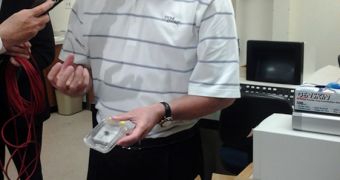The Field Museum in Chicago is now the owner of a small meteorite that is believed to be around 4.6 billion years old, which is at least 100 million years older than our planet. The rock may have been among the first objects to form in the solar system.
The 10-gram sample is taken from a larger meteorite, and was donated to the museum by Lake Forest meteorite collector Terry Boudreaux. The rock was discovered in Sutter's Mill, California, about two weeks ago, by a woman walking her dog. Her attention was caught by the unusual-looking object.
Astronomers now hope to use the small sample to investigate the origins and evolution of the solar system, and perhaps even gain a deeper understanding of the Big Bang, and what happened afterwards.
Field Museum curator of meteorites and physical geology, Philipp Heck, says that the current model explaining the Universe holds that it originated in a dense, hot state of matter, and that the expansion which began 13.75 billion years ago continues even now.
Meteorites such as this one are classified as carbonaceous chondrites, and they are very rare. The last recorded time when a major space rock of this type fell to Earth was in 1969, the investigator says.
“It is a great honor that we will get a piece of this very rare and fantastic meteorite. This is really spectacular, because this is a carbonaceous chondrite, and those are very rare,” adds Heck, as quoted by Northwestern University's MEDILL news service.
A press conference announcing the donation of the meteorite sample was held at the Field Museum on Tuesday morning, May 8. Over the years, Boudreaux, an avid collector, donated several fragments to the museum. “I’m just happy that I can contribute to science, being a lay person,” he said.
The new sample will now be added to the 6,000+ meteorites already at the museum. The collection is managed by scientist Jim Holstein. “We’re always looking for new specimens. We definitely want to have an extreme variety,” he said.
According to statistics, the Field Museum's is the largest non-governmental collection of meteorites in the world. The sample Boudreaux donated is believed to have originated in the Inner Asteroid Belt, which lies between the orbits of Mars and Jupiter.
Heck said that the museum would start creating a special container or casing to enclose the ancient meteorite sample. It will not be displayed to the public until experts can make sure that no foreign contaminants touch it.

 14 DAY TRIAL //
14 DAY TRIAL //